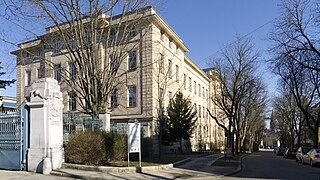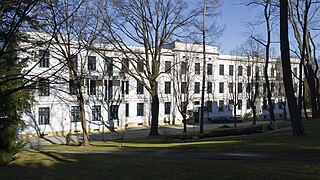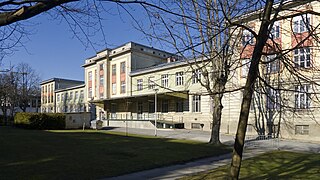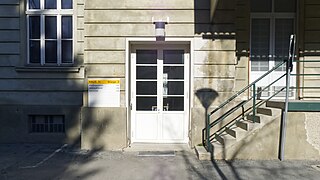Semmelweis Women's Clinic
The Semmelweis Women's Clinic was a gynecological clinic in the 18th district of Währing in Vienna . It was named after the doctor Ignaz Semmelweis .
Location and architecture
The clinic was at Bastiengasse 36–38 in the Gersthof district . It consisted of six five-story pavilions in a park.
In the complex there is a monument to Emperor Franz Joseph I , which was created in 1910 by the sculptor Georg Leisek . It was in the Lainz nursing home until 1936 . A bust depicting Ignaz Semmelweis, a work by the sculptor Rudolf Schmidt from 1944, stands on a corner pillar. The Lower Austrian coat of arms is affixed to the clinic's secessionist lattice portal .
history
The facility was built from 1908 to 1910 on behalf of the Lower Austrian provincial government by the Lower Austrian Provincial Building Authority as a foundling house on the site of the former Gersthofer Castle . The architects were Karl Otto Limbach and Max Haupt . The Lower Austrian state central children's home was housed here. When Vienna was separated from Lower Austria as a separate federal state in 1922 , the city of Vienna took over the institution.
In 1943 the city founded the Semmelweis women's clinic in two pavilions. In 2002 it was incorporated into the Rudolfstiftung municipal hospital of the Vienna Hospital Association (KAV).
As part of the reorganization of the Viennese hospital landscape, the workforce of the Semmelweis Women's Clinic moved to the newly built North Hospital in June 2019 . The Rudolf Foundation continues to use the medical facilities and beds on site.
After that, the buildings are to be given a new use, part of which has been used by the private “AMADEUS international school of music VIENNA” since 2012. Luxury apartments were built on a privatized part of the site. The opposition parties FPÖ and NEOS criticized the sales price as too low and the buyer's proximity to the ruling SPÖ . It has not yet been clarified what re-use will be made for the parks.
Services
Rooming-in has been available in the Semmelweis Women's Clinic since the 1970s . The clinic cared for around 5500 inpatients every year and around 2200 babies were born here every year. The department for gynecology and obstetrics and the department for anesthesiology of the Rudolf Foundation are housed in the clinic . The seven hospital outpatient departments specialized in examinations of the pelvic floor and pelvic floor training , dysplasia , obstetrics, gynecology, psychosomatics , ultrasound for prenatal diagnostics and urogynecology . An interdisciplinary institution was dedicated to the birth of midwives by choice. There was also a breast milk collection point.
In the Semmelweis Women's Clinic there was also a health center for women, parents and girls from the Institute for Women's and Men's Health from 1992 onwards.
photos
Web links
- Semmelweis women's clinic at the Rudolfstiftung Hospital . Memento of the KAV website in the Internet Archive .
Individual evidence
- ^ Dehio-Handbuch Wien. X. to XIX. and XXI. to XXIII. District . Edited by Federal Monuments Office. Anton Schroll, Vienna 1996, ISBN 3-7031-0693-X , pp. 471–472.
- ↑ Vienna. Construction of a building for employees. In: Der Bautechniker , February 28, 13, p. 4 (online at ANNO ). .
- ^ Gersthof on the website of the Währing district museum .
- ↑ a b c Last day of the Semmelweis Clinic. In: wien.orf.at. June 9, 2019, accessed June 9, 2019 .
- ^ "Utilization" of the Semmelweis Women's Clinic on the WSE website, accessed on June 16, 2019.
- ↑ Semmelweis-Areal receives music high school , at wien.gv.at, accessed on February 8, 2014.
- ↑ David Krutzler: Public prosecutors are investigating the privatization of the Semmelweis site. In: derstandard.at . June 28, 2018, accessed June 16, 2019 .
Coordinates: 48 ° 14 ′ 7 ″ N , 16 ° 19 ′ 9 ″ E














